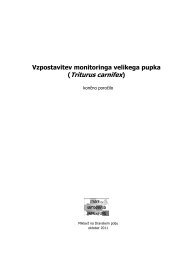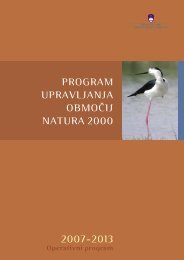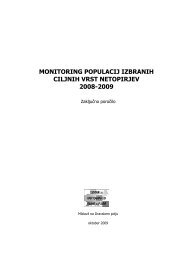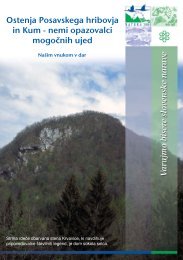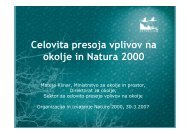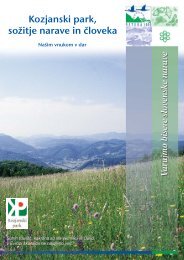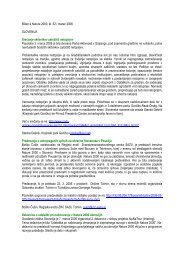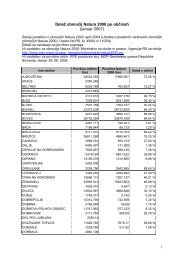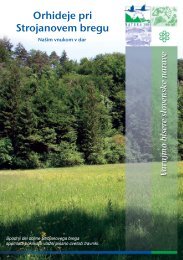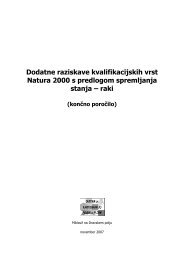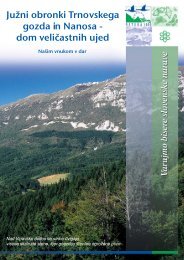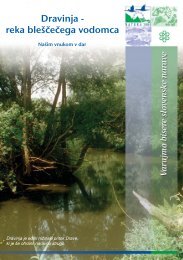VIRGIN FORESTS AND FOREST RESERVES IN ... - Natura 2000
VIRGIN FORESTS AND FOREST RESERVES IN ... - Natura 2000
VIRGIN FORESTS AND FOREST RESERVES IN ... - Natura 2000
Create successful ePaper yourself
Turn your PDF publications into a flip-book with our unique Google optimized e-Paper software.
COST Action E4: Forest Reserves Research Network 123<br />
A specially relevant fact and a sad statement of great concern is that that we are not<br />
supposed to talk about cultural landscape in Europe any more. This landscape has become<br />
an artificial savanna, a non-cultural landscape with occasional remains.<br />
We have to change our opinion about our ancestors completely. The ancestors who were<br />
not able to practice sustainable ways of life because human being became a foreign body<br />
in Nature. This statement needs deeper explanation.<br />
We have to look upon new ways how to team up with our environment. How to find<br />
friendly ways of cohabitation with Nature.<br />
SOME IMPORTANT EXCEPTIONS (FOR FORMER SLOVENIA WITH<strong>IN</strong> AUSTRO-HUNGARIAN<br />
EMPIRE)<br />
As to the way the forests were treated in continental and Mediterranean part of Europe,<br />
Slovenia was no exception. For all these regions, similar history of forest management<br />
can be written (the theory and practice about even-aged forestry, spruce monocultures,<br />
clear-cuts, much the same silvicultural systems, etc.). But rather early we could find some<br />
exceptions in Slovenia due to its special geographical position, and these showed<br />
completely new ways of forest management. These were probably the result of<br />
excessively ruined landscape in this part of Europe, i.e. the disappearance of forests in the<br />
sub-Mediterranean part of Slovenia, the removal of forests of up to 1/3 of the original size<br />
in the most of Slovenia, overexploitation, overcutting, overgrazing in forests, litter<br />
collecting, animal fodder collecting, and pollarding in those still existing forests. The<br />
Slovenian landscape became a torrential landscape, from the Alpine to the sub-Pannonian<br />
region. It is not surprising that very early the Vienna Forestry School developed the<br />
science of 'how to protect lives against torrents and avalanches'. The history tells us about<br />
other exceptions when authorities, forestry organisations, and some individuals started to<br />
be concerned with new ways how to manage the forests in an appropriate, more or less<br />
close-to-nature way.<br />
The example of Josef Ressel as a representative of foresters'<br />
sustainable way of thinking<br />
Let's begin with re-naturalisation of the Karst landscape in the sub-Mediterranean region<br />
of Slovenia. The Karst area was completely ruined for a very long period. In the mid<br />
19 th century there was only 5 - 10% of shrub vegetation distributed in small spots of the<br />
Karst area. Because of these changes living conditions became very severe. Eroded rocky<br />
landscape, drought, heavy winds, extreme heat in vegetation period, overgrazing, lack of<br />
fuel, etc., have contributed to poor living conditions in this area. The land was partly<br />
abandoned. Foresters were the first to start rethinking and to look for new ways to restore<br />
life in this part of Slovenia. There are few foresters who started to re-establish the forests<br />
in this area. Already in the mid 19 th century the forester - generalist Josef Ressel, mainly<br />
employed by the Austrian navy, started to plant new forests in a different way. The<br />
foresters experimented with the so called 'climax tree species' (broad-leaved tree species),<br />
and finally found a pioneer tree species (Pinus nigra) to fit the climate. Josef Ressel was<br />
by nature an inventor, and he became known for many of his patents (e.g. the steamer



